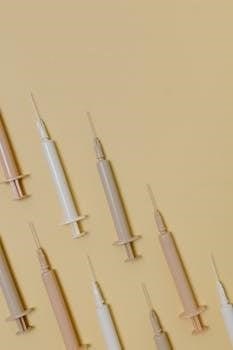Tiziani’s nursing drug guide‚ a resource for nurses and midwives‚ provides reliable and accurate drug information. It aims to support both students and practicing professionals in healthcare settings with current medication data.
Overview of Havard’s Nursing Guide to Drugs
Havard’s Nursing Guide to Drugs‚ a long-standing resource since 1983‚ is now in its 10th or 11th edition‚ depending on the source; This guide is designed for nursing and midwifery students and practitioners‚ offering reliable and up-to-date drug information. It is known for its user-friendly approach‚ making it an accessible tool for those in the field. The guide focuses on providing safe drug administration practices‚ covering essential details such as drug forms‚ actions‚ uses‚ dosages‚ adverse effects‚ and interactions. It’s considered an indispensable resource for both education and clinical practice. Furthermore‚ the guide is structured to present information clearly‚ aiding quick and efficient access to vital medication details. It also includes practical aspects‚ such as dosage calculations and considerations for specific patient groups. Havard’s guide is also trusted by nursing and midwifery professionals in Australia.
Significance for Nursing Practice
The significance of a comprehensive drug guide‚ like Tiziani’s or Havard’s‚ for nursing practice cannot be overstated. These guides serve as crucial tools for nurses and midwives‚ ensuring safe and effective medication administration. They provide access to reliable and up-to-date information that helps in clinical decision-making‚ reducing medication errors‚ and improving patient outcomes. A dependable drug guide enables nurses to quickly reference drug forms‚ actions‚ uses‚ dosages‚ adverse effects‚ and interactions‚ which is essential for safe practice. By offering clear guidelines‚ these guides support nurses in confidently administering medications and educating patients. Moreover‚ the detailed information on drug interactions and adverse effects is vital in preventing harm. The availability of resources like these enhances the quality of care‚ builds confidence among nursing professionals‚ and contributes to a safer healthcare environment. These guides are indispensable for both students learning and experienced nurses practicing.

Understanding Tiziani’s Approach to Drug Information
Tiziani’s approach to drug information emphasizes user-friendly design and clear organization. It classifies drugs by therapeutic class and body system for easy navigation and quick access.
Emphasis on User-Friendly Design
Tiziani’s nursing drug guide prioritizes a user-friendly design‚ ensuring that healthcare professionals can easily access the information they need. The guide is structured to be intuitive‚ making it simple for both nursing and midwifery students‚ as well as experienced practitioners‚ to navigate. Key features‚ such as clear headings‚ concise descriptions‚ and logical organization‚ contribute to the guide’s accessibility. This design philosophy aims to reduce the time spent searching for information‚ allowing nurses to focus more on patient care. The user-friendly approach is a cornerstone of Tiziani’s guide‚ ensuring that essential drug information is readily available when needed. This design consideration reflects the practical needs of busy healthcare professionals who require quick and reliable information at their fingertips. The layout of the guide is designed to minimize confusion and promote efficient use of the resource in demanding clinical environments.
Classification by Therapeutic Class and Body System
Tiziani’s nursing drug guide employs a dual classification system‚ organizing drugs by both therapeutic class and body system. This approach provides nurses with multiple ways to locate information. Classification by therapeutic class groups drugs based on their pharmacological action‚ such as antibiotics or analgesics. This method helps nurses understand how a drug works and its intended effect. Concurrently‚ classification by body system organizes drugs by their primary target‚ such as cardiovascular or respiratory medications. This approach allows nurses to quickly identify drugs relevant to specific organ systems‚ enhancing their ability to manage complex patient cases. The dual classification system facilitates thorough understanding and efficient use of the guide‚ making it a valuable reference tool for healthcare professionals. This method promotes a comprehensive approach to medication management‚ integrating therapeutic action and physiological impact for informed practice.

Key Drug Information Provided
This section of Tiziani’s guide includes essential details such as drug forms‚ actions‚ and uses‚ providing a foundation for safe medication administration and understanding therapeutic effects.
Drug Forms‚ Actions‚ and Uses
Tiziani’s guide meticulously details the various forms in which medications are available‚ such as tablets‚ capsules‚ liquids‚ and injectables‚ ensuring nurses understand the appropriate routes of administration. For each drug‚ the guide elucidates its mechanism of action‚ explaining how it interacts with the body at a molecular level to produce a therapeutic effect. Understanding these actions is vital for predicting patient responses and monitoring efficacy. Moreover‚ the guide specifies the approved uses for each medication‚ outlining the conditions or symptoms it is intended to treat. This comprehensive approach allows nurses to make informed decisions regarding drug selection and administration‚ ultimately promoting patient safety and optimal treatment outcomes. The detailed explanation of forms‚ actions‚ and uses forms a cornerstone of the drug information provided.
Dosage Guidelines and Calculations
Tiziani’s guide offers clear dosage guidelines for each medication‚ taking into account factors like patient age‚ weight‚ and renal function. It emphasizes the importance of accurate calculations‚ providing the necessary formulas for nurses to determine the correct dose. This section includes detailed instructions on how to calculate drug doses and drip rates‚ ensuring that nurses can administer the precise amount of medication required. The guide also considers various routes of administration and their implications for dosage adjustment. By providing comprehensive guidance on dosage calculations‚ Tiziani’s ensures that nurses can confidently and safely administer drugs while minimizing the risk of medication errors and maximizing therapeutic efficacy. The focus on accurate dosage is a cornerstone of safe nursing practice.

Adverse Effects and Interactions
This section of Tiziani’s guide details potential side effects of medications. It also covers important drug interactions‚ helping nurses understand risks and ensure patient safety through informed practice.
Identifying Potential Side Effects
Tiziani’s guide meticulously outlines potential adverse effects associated with each drug‚ a crucial aspect for nurses in patient care. This section emphasizes the importance of recognizing and understanding these effects‚ which can range from mild discomfort to severe‚ life-threatening reactions. The guide provides detailed descriptions of common and less frequent side effects‚ enabling nurses to monitor patients effectively. By clearly listing these potential issues‚ the resource empowers nurses to anticipate‚ assess‚ and manage adverse drug reactions promptly. The guide also educates on differentiating between expected drug responses and genuine adverse events‚ highlighting the need for vigilant observation. It aims to equip nurses with the necessary knowledge to ensure patient safety‚ by accurately identifying and addressing any negative health outcomes related to medication use and promoting the best possible therapeutic outcomes. This proactive approach to side effect management is a cornerstone of safe nursing practice and is thoroughly supported within this section of the guide.
Understanding Drug Interactions
Tiziani’s guide dedicates a significant portion to the complexities of drug interactions‚ a critical area for nurses to master. It explains how combining different medications can lead to altered drug effects‚ either enhancing or diminishing their therapeutic efficacy‚ or even causing unexpected adverse reactions. This section details various types of interactions‚ such as drug-drug‚ drug-food‚ and drug-disease interactions‚ providing a clear explanation of the mechanisms behind these processes. The guide emphasizes the importance of meticulously reviewing a patient’s medication history to identify potential risks. It offers practical advice on how to recognize and manage these interactions‚ including strategies for mitigating their impact. Furthermore‚ it highlights the necessity of regular assessment and communication with the healthcare team when managing patients on multiple medications. This deep dive into drug interactions ensures that nurses can provide safe and effective care. By equipping nurses with this knowledge‚ the guide aims to minimize medication-related complications and improve patient outcomes.

Nursing Considerations and Patient Education
This section provides essential advice for nurses‚ including administration techniques‚ cautions‚ and patient education notes. It emphasizes safe practices and effective communication for improved patient outcomes.
Administration Advice and Cautions
This section of Tiziani’s drug guide is dedicated to providing crucial administration advice and cautions for nurses. It highlights the importance of safe medication practices‚ emphasizing the need for nurses to be well-informed about specific drug administration protocols. Detailed guidance is provided on various routes of administration‚ such as oral‚ intravenous‚ intramuscular‚ and subcutaneous‚ along with specific techniques for each method. Special attention is given to medications that require precise timing‚ dosage adjustments based on patient conditions‚ or special preparation before administration; Furthermore‚ the guide cautions nurses about potential risks associated with certain drugs‚ including contraindications‚ interactions with other medications‚ and adverse reactions. Practical tips for safe medication handling‚ storage‚ and disposal are also included‚ ensuring nurses adhere to best practices for patient safety. It underscores the significance of meticulous documentation of administration and monitoring for any signs of complications.
Patient Education Notes
This part of Tiziani’s guide focuses on providing nurses with essential patient education notes‚ which are designed to empower patients with knowledge about their medications. The notes cover vital aspects of each drug‚ including its purpose‚ how to take it correctly‚ and what to expect during treatment. Nurses are guided on how to effectively communicate complex medical information to patients in an understandable way. Specific instructions on dosage‚ timing‚ and potential side effects are clearly outlined‚ allowing patients to actively participate in their own care. The importance of medication adherence is emphasized‚ with tips on how to integrate medications into daily routines. Furthermore‚ the notes educate patients on what actions to take if they encounter any adverse reactions or have questions. It promotes a collaborative approach to healthcare by ensuring patients are fully informed and engaged in their treatment plans. This section also stresses the importance of culturally sensitive education.
